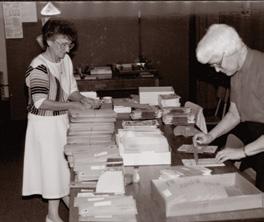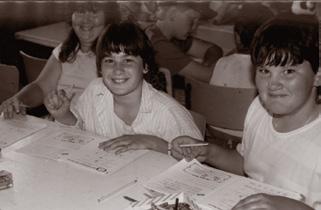
2 minute read
The Best Book of All
More than 60 years ago Canadian Sunday School Mission (CSSM) faced a challenge. Hundreds of boys and girls were coming to camp, but many had no access to Christian teaching at home. Muriel Taylor, who served with CSSM since its inception in 1927, had already been instrumental in developing a Bible memory contest that saw thousands of students memorize hundreds of Scripture verses to earn a free week at camp. She had also spearheaded the creation of Bible correspondence courses in 1931; children could earn a week at camp after completing the course.

Muriel Taylor, circa 1927.
Advertisement
By the mid-1950s it became clear that a different kind of follow-up tool was needed, to provide encouragement and support for children and youth who came to faith at vacation Bible school or summer camp.
The Best Book Club launched in 1957, with the goal to make the Bible known as “the best book of all.” Each month children received booklets with Bible lessons and activities—most written by Muriel—along with opportunities to write letters and memorize Scripture.

Children taking part in CSSM Bible lessons at school.
It was a rousing success; at the height of the club’s popularity, CSSM sent out 10,000 lessons each month. Children mailed in completed lessons; Muriel and her team of volunteers would grade the work, reply to letters, and mail the material back to the students.

Marking lessons and answering letters sent in to the Best Book Club.

CSSM volunteers work on packaging Best Book Club materials.
In addition to the follow-up the Best Book Club provided, children could also earn a free week at camp or a new Bible upon satisfactory completion of the program. Later, the camp portion of the reward became a credit to be used toward camp fees.

CSSM's own printing press allowed for publication of the Best Book Club materials in house.
In 1963, a substantial gift allowed CSSM to publish a secondhand press. Best Book Club materials went into production for the next five decades. Some were translated into other languages, including French, German, and even Greek.
“I cannot express with my poor English the blessing [the lessons] brought to many precious little lives at our camps,” wrote a missionary from Greece. “Around the campfire at the end of each session, many children testified to the blessing they received from the wonderful lessons, so practical and easy to understand.”

Students working on Best Book Club materials in the 1980s.
Interest in the Best Book Club began to wane in the mid-1990s. Enrollment decreased, despite efforts to make the stories and lessons more attractive to a new audience that was turning to technology.
Just a few years later, however, printing operations shut down as nearly obsolete equipment became too expensive to run. The Best Book Club ceased to publish.
While it was the end of an era, it wasn’t the end of the idea. The issue remained: how to create effective post-summer follow-up opportunities with children and youth.
Fast forward to summer 2020 and the advent of the MyCamp app. This new, technology-driven follow-up tool traces its roots to the vision established by the Best Book Club. The method has changed, but the message lives on. MyCamp, like the Best Book Club, aims to disciple children in their ongoing journeys with Jesus, and to instill in them a love for the Bible as “the best book of all.”
(With information from Explosion of the Ordinary: The Ongoing Story of the Canadian Sunday School Mission)




